
Roridula is a genus of evergreen, insect-trapping shrubs, with two species, of about 1⅓–2 m. It is the only genus in the family Roridulaceae. It has thin, woody, shyly branching, upright, initially brown, later grey stems, with lance- to awl-shaped leaves crowded at their tips. The star-symmetrical flowers consist from the outside in of five, green or reddish, free sepals, alternating with five white, pink or purple, free petals. Further to the middle and opposite the sepals are five stamens with the anthers initially kinked down. These suddenly flip up if the nectar-containing swelling at its base is being touched. The center of the flower is occupied by a superior ovary. The leaves and sepals carry many sticky tentacles of different sizes, that trap insects. Roridula does not break down the insect proteins, but bugs of the genus Pameridea prey on the trapped insects. These later deposit their feces on the leaves, which take up nutrients from the droppings. The species can be found in the Western Cape province of South Africa. They are commonly known as dewstick or fly bush in English and vlieëbos or vlieëbossie in Afrikaans.
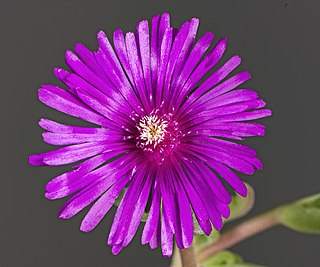
Delosperma is a genus of around 170 species of succulent plants, formerly included in Mesembryanthemum in the family Aizoaceae. It was defined by English botanist N. E. Brown in 1925. The genus is common in southern and eastern Africa, with a few species in Madagascar, Reunion island, Yemen and Saudi Arabia. Delosperma species, as do most Aizoaceae, have hygrochastic capsules, opening and closing as they wet and dry.
This glossary of botanical terms is a list of definitions of terms and concepts relevant to botany and plants in general. Terms of plant morphology are included here as well as at the more specific Glossary of plant morphology and Glossary of leaf morphology. For other related terms, see Glossary of phytopathology, Glossary of lichen terms, and List of Latin and Greek words commonly used in systematic names.
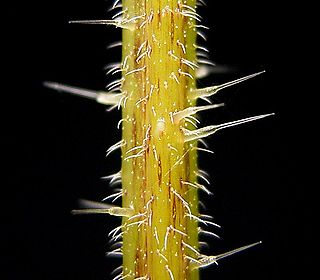
A stinging plant or a plant with stinging hairs is a plant with hairs (trichomes) on its leaves or stems that are capable of injecting substances that cause pain or irritation.

Trichodiadema bulbosum is a succulent plant of the genus Trichodiadema, native to South Africa.

Trichodiadema marlothii is succulent plant of the genus Trichodiadema, native to the Western Cape Province, South Africa, where it is known from the Robertson and Swellendam areas.
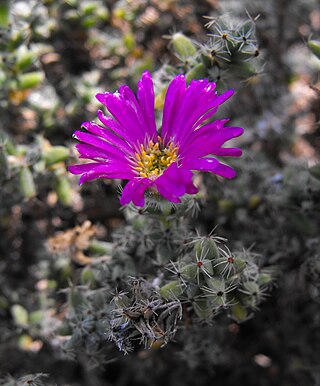
Trichodiadema intonsum is succulent plant of the genus Trichodiadema, native to the Eastern Cape Province, South Africa.

Trichodiadema mirabile is succulent plant of the genus Trichodiadema, native to the Western Cape Province, South Africa, where it is known from the Laingsburg area and especially from south-facing slopes.
Trichodiadema burgeri is succulent plant of the genus Trichodiadema, native to the Western Cape Province, South Africa, where it is known from the Ladismith and Oudtshoorn regions, extending southwards towards Mossel Bay.

Trichodiadema densum is a succulent flowering plant in the fig-marigold family Aizoaceae, native to the Willowmore region of the Western Cape Province, South Africa.
Trichodiadema attonsum is succulent plant of the genus Trichodiadema, native to the Western Cape Province, South Africa, where it is common among pale quartzite rocks in the western Little Karoo region. Unlike most other species in its genus, it does not have a typical diadem on its leaf-tips.
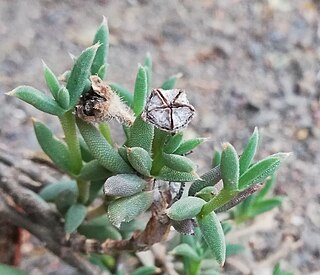
Trichodiadema gracile is succulent plant of the genus Trichodiadema, native to the Western Cape Province, South Africa, where it is common on dry, rocky hillsides in the Overberg region.

Trichodiadema occidentale is succulent plant of the genus Trichodiadema, native to the Western Cape Province, South Africa, where it grows in rocky shale or limestone hills in the Overberg region, and especially in disturbed areas.

Trichodiadema pygmaeum is succulent plant of the genus Trichodiadema, native to the Western Cape Province, South Africa, where it is found in fine-grained soils in the regions of Bredasdorp and Swellendam.
Trichodiadema hallii is succulent plant of the genus Trichodiadema, native to the Ladismith and Calitzdorp areas of the Western Cape Province, South Africa.
Trichodiadema strumosum is succulent plant of the genus Trichodiadema, native to the Western Cape Province, South Africa, where it is found in loam-based soils in the Fynbos vegetation of the Swellendam region.
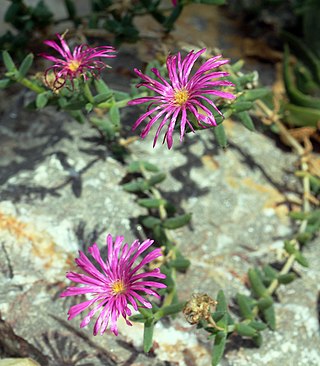
Trichodiadema barbatum is succulent plant of the genus Trichodiadema, native to the Eastern Cape Province, South Africa.

Trichodiadema setuliferum is a succulent plant of the genus Trichodiadema, native to the Karoo regions of the Cape Provinces, South Africa.

Trichodiadema pomeridianum is a succulent plant of the genus Trichodiadema, widespread in the arid central Karoo regions of South Africa.

Trichodiadema orientale is a succulent plant of the genus Trichodiadema, widespread in the arid areas of the Eastern Cape Province, South Africa.















